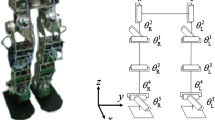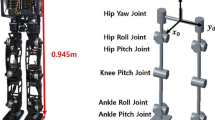Abstract
A passive bipedal walking robot can descend down a small slope without any exertion of external force and only by using the gravity force. By exerting a proper energy to a passive biped robot, its walking speed can be controlled and also it can be forced to walk on flat planes and ascending slopes. In this paper, the proper energy is applied to the robot in three different methods: applying a proper moment to the robot joints, applying a proper moment to the robot’s stance leg, and applying a proper movement to the robot’s upper body. It is found that the first method is not practical, but the second and third methods enhance the stability and speed regulation of the robot. Additionally, the robot can walk on flat planes, ascending or descending slopes. The controlling algorithm used in this paper is a nonlinear algorithm based on tracking of a given mechanical energy pass of a bipedal walking robot.






Similar content being viewed by others
References
Mochon S, McMahon TA (1980) Ballistic walking. J Biomech 13:49–57
Mochon S, McMahon TA (1980) Ballistic walking: an improved model. Math Biosci 52:241–260
McGeer T (1990) Passive dynamic walking. Int J Robot Res 9(2):62–82
Collins SH, Ruina A, Tedrake RL, Wisse M (2005) Efficient bipedal robots based on passive-dynamic walkers. Science 307:1082–1085
Asano F (2012) Efficiency and optimality of two-period limit cycle walking. Adv Robot 26:155–176
Garcia M, Chatterjee A, Ruina A, Coleman M (1998) The simplest walking model: stability, complexity, and scaling. ASME J Biomech Eng 120:281–288
Goswami A, Thuilot B, Espiau B (1998) A study of the passive gait of a compass-like biped robot: symmetry and chaos. Int J Robot Res 17:1282–1301
Wisse M, Schwab AL, Vander Helm FCT (2004) Passive dynamic walking model with upper body. Robotica 22:681–688
Borzova E, Hurmuzlu Y (2004) Passively walking five-link robot. Automatica 40:621–629
Li Q, Tang S, Yang XS (2013) New bifurcations in the simplest passive walking model. Chaos 23:043110
Li Q, Yang XS (2012) New walking dynamics in the simplest passive bipedal walking model. Appl Math Model 36:5262–5271
Gritli H, Khraief N, Belghith S (2012) Period-three route to chaos induced by a cyclic-fold bifurcation in passive dynamic walking of a compass-gait biped robot. Comm Nonlinear Sci Numer Simul 17:4356–4372
Afshar PN, Ren L (2012) Dynamic stability of passive bipedal walking on rough terrain: a preliminary simulation study. J Bion Eng 9:423–433
Safa AT, Alasty A, Naraghi M (2015) A different switching surface stabilizing an existing unstable periodic gait: an analysis based on perturbation theory. Nonlinear Dyn 81:2127–2140
Chyou T, Liddell GF, Paulin MG (2011) An upper-body can improve the stability and efficiency of passive dynamic walking. J Theor Biol 285:126–135
An K, Chen Q (2013) A passive dynamic walking model based on knee-bend behaviour: stability and adaptability for walking down steep slopes. Int J Adv Robot Syst 10:365
Jeon Y, Park YS, Park Y (2013) A study on stability of limit cycle walking model with feet: parameter study. Int J Adv Robot Syst 10:49
Huang Y, Wang QN, Gao Y, Xie GM (2012) Modeling and analysis of passive dynamic bipedal walking with segmented feet and compliant joints. Acta Mech Sinica 28:1457–1465
Collins SH, Wisse M, Ruina A (2001) A three-dimensional passive dynamic walking robot with two legs and knees. Int J Robot Res 20:607–615
Spong MW, Bhatia G (2003) Further results on control of the compass gait biped. In: Proceedings of IEEE/RSJ International Conference on Intelligent Robots and Systems (IROS 2003), pp 1933–1938
Spong MW, Bullo F (2005) Controlled symmetries and passive walking. IEEE Trans Autom Control 50:1025–1031
Ames AD, Gregg RD (2007) Stably extending two-dimensional bipedal walking to three dimensions. In: Proceedings of American Control Conference, pp 2848–2854
Gregg RD, Spong MW (2010) Reduction-based control of three-dimensional bipedal walking robots. Int J Robot Res 29:680–702
Ohta H, Yamakita M, Furuta K (1999) From passive to active dynamic walking. In: Proceedings of IEEE Conference on Decision and Control, pp 3883–3885
Spong MW (1999) Passivity based control of the compass gait biped. In: Proceedings of IFAC Triennial World Congress, pp 19–23
Kuo AD (1999) Stabilization of lateral motion in passive dynamic walking. Int J Robot Res 18:917–930
Suzuki S, Furuta K, Pan Y, Hatakeyama S (2001) Biped walking robot control with passive walker model by new VSC servo. In: Proceedings of American Control Conference, pp 107–112
Pekarek D, Ames AD, Marsden JE (2007) Discrete mechanics and optimal control applied to the compass gait biped. In: Proceedings of IEEE conference on decision and control, pp 5376–5382
Erez T, Smart WD (2007) Bipedal walking on rough terrain using manifold control. In: Proceedings of IEEE/RSJ International Conference on Intelligent Robots and Systems (IROS 2007), pp 1539–1544
Yazdi EA, Alasty A (2008) Stabilization of biped walking robot using the energy shaping method. J Comput Nonlinear Dyn 3:041013.1–041013.8
Iida F, Tedrake R (2010) Minimalistic control of biped walking in rough terrain. Auton Robots 28:355–368
Liu L, Tian Y (2012) Switch control between different speeds for a passive dynamic walker. Int J Adv Robot Syst 9:241
Grizzle JW, Chevallereau C, Sinnet RW, Ames AD (2014) Models, feedback control, and open problems of 3D bipedal robotic walking. Automatica 50:1955–1988
Ames AD (2014) Human-inspired control of bipedal walking robots. IEEE T Autom Control 59:1115–1130
Cao Y, Suzuki S, Hoshino Y (2014) Uphill and level walking of a three-dimensional biped quasi-passive walking robot by torso control. Robotica. doi:10.1017/S0263574714001593
Thomson WT, Dahleh MD (1998) Theory of vibration with applications, 5th edn. Prentice Hall, New Jersey
Author information
Authors and Affiliations
Corresponding authors
Rights and permissions
About this article
Cite this article
Ebrahimi, A., Heydari, M. & Alasty, A. Active control of a passive bipedal walking robot. Int. J. Dynam. Control 5, 733–740 (2017). https://doi.org/10.1007/s40435-016-0225-2
Received:
Revised:
Accepted:
Published:
Issue Date:
DOI: https://doi.org/10.1007/s40435-016-0225-2




